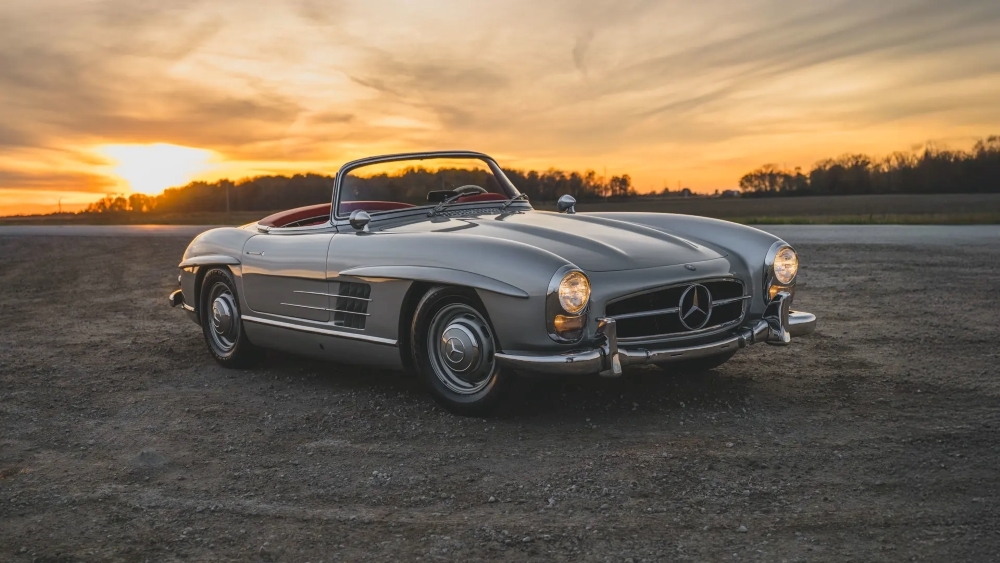The Seven Fastest Classic Cars in the World
Some of the most desirable cars in the world have been built for speed. Every aspect of their design, from the shape of the fuselage to the mechanical components and materials have all been carefully selected to enhance performance. Whether it is a 1930s grand tourer thundering down Le Mans or a contemporary supercar redefining the limits of what’s considered street-legal, the unifying factor is speed. And on 22 May, some of the fastest cars ever built will take the stage at the RM Sotheby’s Milan auction.
Record-shattering rarities and contenders that narrowly missed out on competition glory will stand side by side at the Fonderia Macchi Carlo, each one a snapshot of its era’s engineering ambition and competitive spirit. These vehicles all fit the basic criteria for what it takes to be considered the fastest in the world, though definitions are hardly set in stone.
In order to be considered a recordbreaker, a car must be street-legal, built to be used by actual customers and not just on the racetrack. It must also be able to operate under the same design specs that allowed it to achieve maximum speeds during testing. This has led to its share of debates and controversies as some models attempt to bend the rules.
The seven cars we are looking at below, however, are unquestionably at the top of the game. Each has pushed boundaries of what can be achieved on the road and is a legend in its class.
.jpg?width=1000&height=651&name=unnamed%20(85).jpg)
Mercedes-Benz 300SL Gullwing
Some call it the world’s first supercar, and while purists might argue about the engine layout, the Mercedes-Benz 300 SL Gullwing lets its credentials do the talking. A pioneering spaceframe chassis and a fuel-injected straight-six engine capable of delivering 215 horsepower helped achieve a top speed that its rivals could never hope to match.
In 1958, a one-way timed run hit 150.7 mph, which was well short of the 160 mph it claimed to reach, but more than enough to crown it the fastest production car on the planet, beating the Jaguar XK120, former holder of the speed crown, by a full 25 mph.
Lamborghini Miura P400 SV by Bertone
The Lamborghini Miura may not have invented the mid-engined supercar, but it did put it under the global spotlight. With styling by Marcello Gandini and a howling V-12 courtesy of Giotto Bizzarrini, the Miura was a revolution in both form and speed. It was also an elegant contrast to the AC Cobra 427, which held the title of world’s fastest car prior to that, and was known for its raw, unpolished aggression.
A P400 clocked 171 mph in 1967, raising the bar for performance across the board and leading to its own (brief) unseating by rival Ferrari, who issued a solid challenge with a more traditional front-engined car. By 1970 Lamborghini had secured the title again thanks to the P400 S, which achieved a blazing 179.3 mph.
Ferrari 365 GTB/4 Daytona Berlinetta by Scaglietti
Even as the Lamborghini Miura shook up the industry, Enzo Ferrari stuck firmly to a front-engined layout. That conviction delivered one last roar in the form of the 365 GTB/4 Daytona. Designed by Pininfarina’s Leonardo Fioravanti and powered by a 4.4-litre Colombo V-12 with 347 bhp, the Daytona was capable of hitting 174 mph, more than enough to claim the title of world’s fastest production car.
What made the Daytona remarkable wasn’t just its speed, but its civility. This wasn’t a stripped-down supercar, but a grand tourer capable of effortless high-speed cruising across countries. Still, mid-engined designs had an undeniable aerodynamic advantage, and Lamborghini reclaimed the crown shortly after.
Lamborghini Countach 25th Anniversary Edition by Bertone
Lamborghini’s reign as top-speed king didn’t end with the Miura. In 1982, the Countach LP500 S reasserted the carmaker’s dominance. While the earlier LP400 S added a dramatic rear wing that improved stability but clipped top-end speed, the LP500 S countered with a larger 4.8-litre V-12 producing 370 bhp—enough to hit 182 mph in testing.
A year later, Ruf’s BTR clocked 190 mph, pushing Lamborghini to respond with the 1985 LP5000 QV. With a 5.4-litre, four-valve-per-cylinder V-12 and six Weber carburettors, it delivered a ferocious 449 bhp. Its top speed of 190.1 mph set a Guinness World Record, though questions lingered over the factory-modified airbox used in testing.
Porsche 959 ‘Speedster’
The Porsche 959 was built for competition, but exceeded its Group B ambitions and was seen as the eventual successor to the 911 Turbo. That future never materialised, as the car’s build cost was double its sticker price, making it unsustainable for mass production. When global markets took a sharp downturn in the late ’80s and early ’90s, Porsche was on the road to bankruptcy and was forced to shelve the 959 to help keep its head above water.
Yet the 959’s legacy is untouchable. It introduced water cooling, all-wheel drive, active suspension, sequential twin-turbos, and exotic materials to Porsche’s road cars. It was a technical marvel, and blisteringly fast: it achieved 197 mph in a Komfort model, while the Sport variant managed 198 mph. The even rarer 959 S pushed that to 211 mph, narrowly missing a return to the top after the Ruf CTR’s 212 mph record.
Ferrari F40
While the Porsche 959 Sport and Ruf CTR flirted with the edges of what defines a "production car," Ferrari’s F40 left no room for debate. Its popularity resulted in the production of over 1,100 units in comparison to the double-digits runs of the aforementioned cars. Although a top speed of 201mph was claimed, apparently making it the first production car to break the 200 barrier, independent tests couldn’t take it past 199 mph. Ferrari maintained its claim, however, which remains a source of debate.
Born from the ashes of Group B and shaped by the lessons of the 288 GTO Evoluzione and Lancia’s LC2 programme, the F40 was a no-frills weapon. With 471 bhp from a twin-turbocharged 2.9-litre V8 and a featherweight chassis made from Kevlar, carbon fibre, and aluminium, it was raw, unforgiving, and utterly focused. The F40 was the last car to be approved by Enzo Ferrari himself, making it a fitting legacy to his vision.
Jaguar XJ220
Often overlooked but undeniably impressive, the Jaguar XJ220 remains one of the best-value record breakers of its era. Originally promised with a V-12 and four-wheel drive, the production version arrived during a recession with a twin-turbo V6 instead. Consequently, orders were cancelled and warehouses languished with unsold cars. Yet beneath the controversy was a serious machine: futuristic, fearsomely fast, and every bit a contender.
With 524 bhp, the XJ220 hit 217.1 mph at the Nardò Ring under semi-optimised conditions, with rev limit raised and catalytic converters removed. Even in true road-going form, it reached a blistering 210.5 mph. Outmatched by the Bugatti EB110 and Ruf CTR, the XJ220 may not be a record-holder, but it remains a significant part of automotive history.



